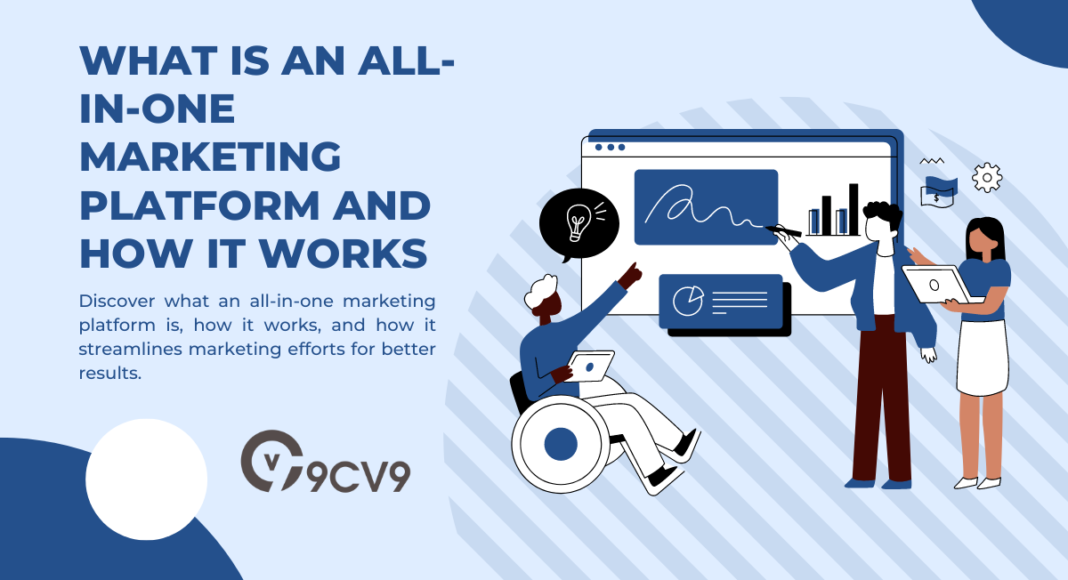Key Takeaways
- Streamlined Marketing Processes: An all-in-one marketing platform integrates tools like email, social media, CRM, and analytics to simplify workflows and improve efficiency.
- Enhanced Customer Engagement: These platforms provide personalized marketing automation and multi-channel management, ensuring a seamless and consistent customer experience.
- Scalability and Growth: All-in-one marketing platforms offer flexibility, allowing businesses to scale their marketing efforts as they grow and adapt to changing needs.
In today’s rapidly evolving digital landscape, businesses are continuously seeking efficient ways to manage their marketing efforts across multiple channels.
From email campaigns and social media engagement to customer relationship management and performance analytics, the sheer number of tools and platforms needed to execute effective marketing strategies can be overwhelming.

Enter the all-in-one marketing platform—a powerful solution that combines a range of marketing tools into one cohesive system, simplifying operations and driving efficiency for businesses of all sizes.
An all-in-one marketing platform is designed to streamline your marketing efforts by offering a unified system where all your essential marketing functions coexist.
Instead of juggling between different tools for email marketing, social media scheduling, analytics, and customer relationship management (CRM), businesses can now access all these features within a single, integrated platform.
This not only saves time and reduces costs but also ensures that all marketing efforts are aligned and data-driven, leading to more consistent and effective campaigns.
For businesses looking to scale, maintain a competitive edge, and maximize ROI, adopting an all-in-one marketing platform can be a game-changer.
By offering seamless integration of marketing activities, such platforms eliminate the friction caused by data silos and disconnected systems. Marketing teams can work more collaboratively, with access to real-time insights and automation tools that improve productivity and drive better results.
In this blog, we will explore what exactly an all-in-one marketing platform is, how it works, and why it is becoming an essential tool for businesses looking to optimize their marketing efforts.
We will dive into the core features that define these platforms, explain their functionality, and provide insights into the many advantages they offer.
Additionally, we will look at some of the top all-in-one marketing platforms available today, giving you a clearer understanding of how they can transform your business’s marketing strategy.
Whether you’re a small business aiming for growth or a large enterprise managing complex marketing campaigns, an all-in-one marketing platform can be the key to staying ahead in a competitive marketplace.
By the end of this guide, you’ll not only grasp the concept of an all-in-one marketing platform but also understand how to choose the right one for your business needs.
Ready to transform your marketing processes into a well-oiled, integrated machine?
Let’s dive in.
Before we venture further into this article, we would like to share who we are and what we do.
About 9cv9
9cv9 is a business tech startup based in Singapore and Asia, with a strong presence all over the world.
With over eight years of startup and business experience, and being highly involved in connecting with thousands of companies and startups, the 9cv9 team has listed some important learning points in this overview of What is an All-in-One Marketing Platform and How It Works.
If your company needs recruitment and headhunting services to hire top-quality employees, you can use 9cv9 headhunting and recruitment services to hire top talents and candidates. Find out more here, or send over an email to [email protected].
Or just post 1 free job posting here at 9cv9 Hiring Portal in under 10 minutes.
What is an All-in-One Marketing Platform and How It Works
- Core Features of an All-in-One Marketing Platform
- How an All-in-One Marketing Platform Works
- Advantages of Using an All-in-One Marketing Platform
- How to Choose the Right All-in-One Marketing Platform
1. Core Features of an All-in-One Marketing Platform
An all-in-one marketing platform is designed to provide businesses with a comprehensive set of tools to manage, execute, and track their marketing efforts in one place.
These platforms streamline multiple marketing tasks, allowing businesses to save time, reduce costs, and improve overall efficiency.

Below are the core features commonly found in an all-in-one marketing platform, with relevant examples to demonstrate their impact.
1. Email Marketing
Email marketing remains a vital component of any digital marketing strategy, and all-in-one platforms typically offer robust tools to manage email campaigns seamlessly.
- Email Campaign Management
- Create, schedule, and send targeted email campaigns to specific segments of your audience.
- Example: HubSpot allows users to design personalized emails with drag-and-drop functionality and automated workflows for lead nurturing.
- Pre-built Templates
- Access to customizable templates that are optimized for various industries and campaign types.
- Example: ActiveCampaign provides a wide array of mobile-responsive email templates that simplify the design process.
- Automation Features
- Set up automated sequences, such as welcome emails or abandoned cart reminders, to engage customers at the right time.
- Example: Mailchimp offers automation workflows that trigger emails based on user behavior, such as website visits or email opens.
- A/B Testing
- Test different email subject lines, designs, or content to see what resonates best with your audience.
- Example: GetResponse allows for A/B testing of up to five different variations of an email to optimize performance.
- Detailed Analytics
- Track open rates, click-through rates (CTR), and conversion rates to gauge campaign effectiveness.
- Example: Constant Contact provides detailed reports on email engagement, helping businesses refine their strategies.
2. Social Media Management
Social media is a critical channel for customer engagement, brand awareness, and lead generation. All-in-one platforms often integrate social media management tools to simplify this process.
- Content Scheduling and Publishing
- Plan and schedule posts across multiple platforms (Facebook, Instagram, Twitter, LinkedIn) from one central dashboard.
- Example: Hootsuite’s social media management tool, integrated with platforms like HubSpot, allows users to schedule posts across multiple channels.
- Social Listening Tools
- Monitor mentions, hashtags, and relevant conversations to understand your brand’s reputation and trends.
- Example: Zoho Social helps businesses keep track of brand mentions and relevant keywords, making it easier to engage with their audience.
- Engagement Metrics
- Track likes, shares, comments, and reach to measure the performance of your social media campaigns.
- Example: Buffer provides detailed insights into social media performance, including follower growth, engagement rates, and reach per post.
- Integrated Social Ads Management
- Manage paid social media campaigns directly from the platform.
- Example: ActiveCampaign allows you to integrate Facebook Ads and track performance alongside other marketing efforts.
3. Customer Relationship Management (CRM)
A CRM system is an essential feature in most all-in-one marketing platforms, helping businesses manage interactions with current and potential customers.
- Contact and Lead Management
- Store and organize customer contact information and track interactions with leads and prospects.
- Example: HubSpot CRM provides an intuitive interface to manage contacts, track emails, and view the history of interactions in one place.
- Lead Scoring
- Automatically score leads based on their behavior, such as email opens or website visits, to prioritize follow-up efforts.
- Example: Zoho CRM assigns lead scores based on user engagement, helping businesses focus on high-value prospects.
- Sales Funnel Management
- Visualize and track where leads are in the sales funnel to ensure timely follow-ups.
- Example: Salesforce offers pipeline management tools that allow businesses to see the progress of deals and move leads through the funnel efficiently.
- Segmentation
- Segment customers based on various criteria (e.g., location, purchase history, behavior) for targeted marketing efforts.
- Example: Mailchimp’s CRM allows businesses to segment their audience based on behavior or demographics for personalized campaigns.
4. Marketing Automation
Marketing automation is one of the most powerful tools within an all-in-one marketing platform, allowing businesses to streamline repetitive tasks and enhance efficiency.
- Automated Workflows
- Set up predefined actions, such as sending follow-up emails or nurturing leads based on their behavior.
- Example: ActiveCampaign’s automation feature enables users to create sophisticated workflows that trigger actions based on user engagement (e.g., email clicks, site visits).
- Drip Campaigns
- Automatically send a series of emails to nurture leads over time.
- Example: HubSpot allows users to set up drip campaigns that adjust messaging based on user behavior and engagement.
- Lead Nurturing
- Build relationships with prospects through personalized and automated content.
- Example: Marketo provides detailed automation tools for lead nurturing, helping users guide prospects through the sales funnel with minimal manual effort.
- Event Triggers
- Trigger marketing actions (like sending an email or offering a discount) based on specific user behaviors.
- Example: GetResponse automates actions such as sending follow-up emails based on user clicks or purchase behavior.
5. Analytics and Reporting
An all-in-one marketing platform should offer comprehensive analytics to track and measure the effectiveness of your campaigns across all channels.
- Centralized Reporting Dashboard
- Access all your campaign performance metrics in one place, making it easier to see how each effort contributes to overall marketing success.
- Example: HubSpot provides a unified dashboard where users can view performance data from email, social media, and web traffic in real time.
- Cross-Channel Performance Tracking
- Measure the effectiveness of different marketing channels (e.g., email, social media, website traffic) from a single interface.
- Example: Zoho MarketingHub offers insights into how each marketing channel contributes to lead generation and sales.
- Customizable Reports
- Create tailored reports to highlight key performance indicators (KPIs) most relevant to your business.
- Example: Salesforce allows users to generate custom reports on everything from lead generation to sales performance, making it easy to share insights with stakeholders.
- Conversion Rate Tracking
- Monitor the percentage of visitors or leads that convert into customers, helping you understand the ROI of your campaigns.
- Example: Google Analytics (when integrated with platforms like HubSpot or Marketo) provides in-depth conversion tracking, including goals and e-commerce tracking.
6. Landing Page and Form Builders
All-in-one marketing platforms often come with tools to create and optimize landing pages and forms, which are essential for lead capture.
- Drag-and-Drop Landing Page Builder
- Design landing pages without needing to code, making it easy to set up pages for specific campaigns or promotions.
- Example: Unbounce, when integrated into platforms like ActiveCampaign, allows users to create high-converting landing pages using simple drag-and-drop functionality.
- Form Builders
- Create custom forms for lead capture, event registrations, or surveys.
- Example: HubSpot provides easy-to-use form builders that can be integrated into landing pages or websites to capture leads directly.
- A/B Testing for Landing Pages
- Test different landing page designs or messaging to optimize for conversions.
- Example: Instapage, integrated with all-in-one platforms like Mailchimp, offers robust A/B testing features to refine landing pages for better conversion rates.
These core features illustrate why an all-in-one marketing platform is such a valuable tool for businesses seeking to streamline their marketing efforts.
From email marketing and social media management to CRM, marketing automation, and analytics, these platforms provide a holistic solution that saves time, improves collaboration, and drives better results.
The seamless integration of multiple marketing functions within a single platform allows businesses to focus on strategy and execution rather than managing disparate tools, making all-in-one platforms essential in the modern marketing landscape.
2. How an All-in-One Marketing Platform Works

An all-in-one marketing platform simplifies the complexities of managing marketing efforts by integrating various tools and functionalities into a single cohesive system.
Understanding how these platforms work is essential for businesses looking to streamline their marketing operations, enhance collaboration, and achieve better results.
Below, we explore the mechanics of an all-in-one marketing platform, breaking it down into key components and processes.
1. Integration of Various Tools
One of the most significant advantages of an all-in-one marketing platform is its ability to integrate multiple marketing tools into one interface. This integration allows for seamless data flow and communication between different marketing functions.
- Unified Dashboard
- Provides a centralized view of all marketing activities, including campaigns, performance metrics, and customer interactions.
- Example: HubSpot’s dashboard allows users to monitor email campaigns, social media performance, and website traffic all in one place.
- Cross-Functional Data Sharing
- Automatically syncs data between tools (e.g., leads from forms go directly into the CRM).
- Example: When a lead fills out a form on a landing page, their information is immediately captured in the CRM, enabling timely follow-ups.
- Reduced Data Silos
- Eliminates isolated data systems by centralizing information, making it easier for teams to collaborate and make informed decisions.
- Example: Zoho MarketingHub integrates customer data from various channels, allowing marketers to access comprehensive insights about customer behavior.
2. Simplifying Marketing Workflows
All-in-one platforms streamline marketing workflows by automating repetitive tasks and providing intuitive tools that simplify campaign management.
- Task Automation
- Automates routine marketing tasks, such as sending follow-up emails or scheduling social media posts, freeing up time for strategic initiatives.
- Example: ActiveCampaign allows users to set up automated workflows that trigger specific actions based on user behavior, like sending a welcome email when a new lead is added.
- Campaign Management
- Users can create, launch, and monitor campaigns from a single interface, reducing the complexity associated with using multiple tools.
- Example: Mailchimp’s all-in-one platform enables users to design email campaigns, set up landing pages, and track performance, all without switching platforms.
- Collaboration Features
- Offers tools that facilitate teamwork, such as shared access to projects, communication channels, and feedback mechanisms.
- Example: With features like comments and task assignments, platforms like HubSpot enhance collaboration among team members working on a campaign.
3. Unified Data and Insights
An all-in-one marketing platform provides comprehensive analytics and reporting capabilities, allowing businesses to track performance and make data-driven decisions.
- Centralized Analytics
- Combines data from various marketing channels to provide a holistic view of performance metrics.
- Example: Google Analytics, when integrated with an all-in-one platform like HubSpot, gives users insights into website traffic, user behavior, and conversion rates.
- Customizable Reporting
- Users can create tailored reports based on specific KPIs, ensuring they focus on metrics that matter most to their business objectives.
- Example: Salesforce allows users to generate custom reports that highlight lead conversion rates, campaign effectiveness, and sales performance.
- Real-Time Insights
- Access to real-time data enables quick adjustments to campaigns based on performance trends.
- Example: Constant Contact provides users with live reporting on email engagement metrics, allowing for immediate optimization of ongoing campaigns.
4. Enhanced Customer Journey Management
An all-in-one marketing platform enables businesses to manage and optimize the entire customer journey, from lead generation to post-sale engagement.
- Lead Capture and Nurturing
- Use forms, landing pages, and pop-ups to capture leads and nurture them through automated workflows.
- Example: GetResponse’s landing page builder allows businesses to create customized landing pages that directly funnel leads into nurturing sequences.
- Segmentation and Targeting
- Segment audiences based on various criteria (e.g., demographics, behavior) to deliver personalized marketing messages.
- Example: Mailchimp enables users to segment their audience for targeted email campaigns, resulting in higher engagement rates.
- Personalized Communication
- Leverage customer data to send tailored messages that resonate with individual needs and preferences.
- Example: ActiveCampaign uses dynamic content in emails that changes based on user interactions, ensuring relevance in communications.
5. Integrated Marketing Automation
Automation is a cornerstone of how all-in-one marketing platforms operate, helping businesses enhance efficiency and reduce manual labor.
- Workflow Automation
- Set up automated workflows that manage various marketing tasks, from lead scoring to email sequences, without manual intervention.
- Example: HubSpot allows users to create complex workflows that automate lead nurturing based on user actions, significantly reducing the need for manual follow-up.
- Behavior-Based Triggers
- Automate actions based on specific user behaviors, such as clicks, downloads, or purchases.
- Example: If a customer downloads a whitepaper, platforms like Pardot can trigger a series of emails offering related content or services.
- Event-Based Marketing
- Utilize automation to send targeted campaigns based on customer events, such as birthdays, anniversaries, or purchase anniversaries.
- Example: Mailchimp automates birthday emails with special offers to enhance customer loyalty and engagement.
6. Continuous Optimization and Testing
An all-in-one marketing platform facilitates continuous improvement through testing and optimization, ensuring campaigns remain effective over time.
- A/B Testing
- Users can test different versions of emails, landing pages, or ad copy to determine which performs better.
- Example: Unbounce’s landing page builder allows users to create multiple versions of a page to see which one converts more effectively.
- Performance Metrics Analysis
- Analyze key performance indicators (KPIs) to assess campaign effectiveness and identify areas for improvement.
- Example: ActiveCampaign provides detailed analytics that allow marketers to evaluate the performance of their automation sequences.
- Feedback Loops
- Gather customer feedback through surveys or polls to inform future marketing strategies.
- Example: SurveyMonkey integrates with platforms like HubSpot to collect customer insights that help refine marketing tactics.
Understanding how an all-in-one marketing platform works is crucial for businesses aiming to leverage its full potential.
By integrating various tools, simplifying workflows, providing unified insights, and enhancing customer journey management, these platforms empower marketers to execute more effective and efficient campaigns.
The automation and optimization capabilities further streamline processes, allowing businesses to focus on strategic initiatives that drive growth.
With the right all-in-one marketing platform, businesses can transform their marketing efforts and achieve lasting success in the competitive digital landscape.
3. Advantages of Using an All-in-One Marketing Platform
All-in-one marketing platforms provide businesses with a powerful solution to streamline their marketing efforts, centralize operations, and drive efficiency.
By integrating multiple marketing tools into a single, cohesive system, these platforms offer numerous advantages that can enhance performance, reduce costs, and simplify campaign management.
Below, we will explore the key advantages of using an all-in-one marketing platform and how these benefits translate into better outcomes for businesses of all sizes.
1. Streamlined Marketing Operations
One of the core advantages of an all-in-one marketing platform is the ability to centralize all marketing activities into one interface, leading to more efficient operations.
- Single Dashboard for All Campaigns
- Manage email campaigns, social media, content marketing, and paid advertising from one unified platform.
- Example: Platforms like HubSpot provide a single dashboard that allows businesses to monitor multiple campaigns, track performance, and make real-time adjustments without switching between different tools.
- Reduced Complexity
- No need to juggle different platforms for various tasks; everything is integrated, reducing complexity and the learning curve.
- Example: GetResponse integrates email marketing, landing pages, and automation, ensuring marketers don’t need to navigate multiple software systems.
- Synchronized Tools
- Tools like CRM, email marketing, social media management, and analytics are interconnected, creating a seamless workflow.
- Example: With Zoho CRM, all data from lead generation, email campaigns, and customer support funnels directly into one system, improving coordination and collaboration.
2. Cost Efficiency
Using an all-in-one marketing platform is often more cost-effective than subscribing to multiple specialized tools, offering savings in both time and money.
- Lower Subscription Costs
- Rather than paying for multiple software subscriptions, an all-in-one platform typically offers all services for a single fee.
- Example: Platforms like ActiveCampaign combine email marketing, CRM, and automation tools into one package, significantly reducing overall subscription costs compared to using separate tools.
- No Additional Integrations Required
- No need to invest in third-party integrations or developers to link disparate software systems, which can add to overall costs.
- Example: Mailchimp offers built-in features such as email marketing and automation, eliminating the need for expensive integrations.
- Time Savings
- With everything in one place, marketers spend less time switching between tools and managing multiple accounts, resulting in faster campaign execution.
- Example: Marketo’s integrated platform saves time by enabling users to manage content, automation, and analytics from a single point of access, leading to quicker turnarounds on campaigns.
3. Enhanced Data Centralization and Accessibility
All-in-one platforms bring all your data into one centralized hub, providing better insights and easier access to information.
- Unified Customer Data
- Combines data from multiple sources (email, social media, web analytics) into a single system for comprehensive customer profiles.
- Example: HubSpot’s CRM allows users to view customer interactions from emails, web forms, and social media in one place, making it easier to personalize marketing efforts.
- Better Data Analysis
- With all your data in one location, marketers can run detailed reports and analyze trends across channels to make data-driven decisions.
- Example: Salesforce provides users with a detailed view of their sales funnel, marketing KPIs, and customer engagement, all from a unified analytics dashboard.
- Real-Time Access
- Teams can access updated data in real-time, enabling quicker responses to campaign performance and customer needs.
- Example: Constant Contact offers real-time tracking of email campaigns, allowing businesses to monitor engagement rates as they happen and make immediate adjustments.
4. Improved Collaboration Across Teams
All-in-one platforms foster better collaboration among marketing, sales, and customer service teams by ensuring everyone has access to the same tools and data.
- Shared Access to Campaign Data
- Marketing, sales, and support teams can work from the same platform, ensuring all departments have access to the most up-to-date information.
- Example: Zoho’s integrated marketing and sales suite ensures both teams can access lead data and collaborate on customer journeys, improving overall alignment and reducing miscommunication.
- Role-Based Permissions
- Assign role-based permissions to team members, allowing each department to access the tools and data relevant to their responsibilities.
- Example: In HubSpot, marketing teams can manage campaigns while sales teams track leads and CRM data, all while keeping sensitive information protected with role-based access control.
- Simplified Communication
- Built-in communication tools enable better collaboration between team members, ensuring everyone is on the same page during campaign planning and execution.
- Example: Hootsuite’s team collaboration features allow social media managers to coordinate with other departments, making it easy to approve content and share insights.
5. Automation of Marketing Processes
Automation is a major benefit of using all-in-one platforms, enabling businesses to streamline repetitive tasks and focus on strategy.
- Automated Email Campaigns
- Create automated email sequences based on customer behavior, such as abandoned cart reminders or welcome series.
- Example: ActiveCampaign allows businesses to set up automated email workflows that are triggered by specific user actions, improving engagement and driving conversions without manual intervention.
- Lead Scoring and Nurturing
- Automate lead scoring to prioritize high-value prospects and create personalized nurture sequences based on their activity.
- Example: In Marketo, leads are automatically scored based on their behavior, ensuring sales teams focus on the most qualified leads and provide personalized communication to nurture them effectively.
- Social Media Scheduling
- Automatically schedule social media posts across multiple channels, ensuring consistent engagement without manual effort.
- Example: Hootsuite allows marketers to pre-schedule social media posts across platforms like Twitter, Facebook, and Instagram, ensuring timely posting and freeing up time for other tasks.
6. Scalability for Growing Businesses
An all-in-one marketing platform is designed to grow with your business, making it a scalable solution that can meet the evolving needs of companies.
- Adaptable Features
- Start with basic features and gradually scale up to more advanced tools as your business grows.
- Example: HubSpot offers scalable solutions, from free CRM tools for small businesses to advanced marketing automation and analytics features for enterprises.
- Expandable Customer Database
- As your customer base grows, an all-in-one platform can easily accommodate more contacts, leads, and data without requiring additional software.
- Example: Mailchimp offers scalable contact management, allowing businesses to add and manage new leads as they grow their subscriber lists.
- Flexible Pricing Models
- Many platforms offer tiered pricing based on the size of your business or the number of contacts, making it easy to upgrade as your marketing needs evolve.
- Example: Zoho offers flexible pricing plans, allowing businesses to choose a package that suits their current needs and upgrade as they expand.
7. Consistent Brand Messaging
All-in-one marketing platforms help maintain consistent branding across various channels by centralizing content creation and distribution.
- Brand Templates and Guidelines
- Store brand assets, such as templates, logos, and guidelines, ensuring consistent use across all marketing materials.
- Example: Canva Pro integrates with Mailchimp to allow marketers to create branded email templates that can be used consistently across all campaigns.
- Cross-Channel Consistency
- Ensure consistent messaging across email, social media, and web content by managing all communications from one platform.
- Example: Constant Contact allows businesses to manage email campaigns, social media posts, and event marketing from a single platform, ensuring brand consistency across channels.
- Content Personalization
- Create personalized content for different audience segments while maintaining overall brand coherence.
- Example: HubSpot’s content management system allows users to personalize website content based on customer behavior, keeping the message relevant while staying true to the brand.
8. Continuous Optimization
With built-in analytics and testing features, all-in-one marketing platforms allow for continuous campaign optimization, ensuring better results over time.
- A/B Testing
- Test different versions of emails, landing pages, or ads to find the most effective variation.
- Example: Unbounce offers A/B testing tools that allow users to test landing page variations, optimizing conversion rates.
- Performance Tracking
- Track key performance indicators (KPIs) in real-time and make data-driven decisions to improve ongoing campaigns.
- Example: HubSpot’s reporting tools provide real-time insights into campaign performance, helping businesses optimize campaigns for better results.
- Campaign Adjustments
- Make real-time adjustments to campaigns based on performance data, ensuring better results without waiting for post-campaign analysis.
- Example: ActiveCampaign allows users to tweak email workflows, content, and segmentation in response to real-time engagement data.
The advantages of using an all-in-one marketing platform extend across all aspects of marketing operations, from streamlining workflows and centralizing data to improving collaboration and enabling automation.
Businesses of all sizes can benefit from the cost efficiency, scalability, and enhanced campaign management offered by these platforms.
By leveraging the power of an integrated marketing solution, companies can boost their performance, create a seamless customer experience, and achieve better outcomes from their marketing efforts.
4. How to Choose the Right All-in-One Marketing Platform

Choosing the right all-in-one marketing platform for your business is a critical decision that impacts the efficiency of your marketing efforts, customer relationships, and overall business growth.
With a multitude of options available, it can be overwhelming to identify the best platform that aligns with your specific needs.
By evaluating your business goals, budget, feature requirements, and the platform’s scalability, you can make an informed decision.
In this section, we will break down the key factors to consider when selecting the right all-in-one marketing platform for your business.
1. Assess Your Business Needs
Before choosing a platform, it’s important to have a clear understanding of your business’s unique marketing requirements. This ensures that the platform you select has the right tools to meet your goals.
- Define Marketing Objectives
- Consider your marketing strategy—whether it’s lead generation, email marketing, social media management, or sales funnel optimization.
- Example: If your primary goal is to nurture leads through email campaigns, a platform like ActiveCampaign, which excels in email automation, might be the right fit.
- Evaluate Current Challenges
- Identify pain points in your current marketing processes. Are you struggling with data integration, campaign tracking, or customer segmentation?
- Example: Businesses that face challenges in managing multiple marketing channels may benefit from platforms like HubSpot, which offers CRM, email, and social media tools all in one place.
- Understand Team Capabilities
- Consider the skills and expertise of your marketing team. Are they tech-savvy, or do they need a user-friendly, intuitive platform?
- Example: If your team lacks technical expertise, platforms like Mailchimp offer an easy-to-use interface and simple drag-and-drop features for creating campaigns.
2. Identify Essential Features
Each all-in-one marketing platform offers different features, so it’s essential to identify which ones are non-negotiable for your business’s marketing operations.
- Email Marketing and Automation
- Ensure the platform includes robust email marketing capabilities with automation workflows to engage your audience at various stages of the funnel.
- Example: HubSpot and Mailchimp both offer advanced email automation tools that allow businesses to create personalized, triggered email sequences based on customer behavior.
- CRM Integration
- A good all-in-one platform should have a customer relationship management (CRM) system or integrate with your existing CRM to centralize customer data.
- Example: Salesforce’s Marketing Cloud is ideal for businesses that prioritize CRM integration to enhance lead management and sales coordination.
- Social Media Management
- If social media is a key part of your strategy, the platform should offer features to schedule posts, monitor engagement, and track performance across multiple social channels.
- Example: Hootsuite’s integration with CRM and marketing tools makes it a strong contender for businesses looking to manage social media, track engagement, and collaborate across teams.
- Analytics and Reporting
- Look for platforms that provide comprehensive reporting and analytics to track performance and measure ROI.
- Example: Marketo excels in delivering detailed campaign analytics, helping businesses understand their audience and refine their strategies based on performance data.
- Landing Page and Form Builders
- The ability to create high-converting landing pages and forms is crucial for capturing leads and growing your customer base.
- Example: GetResponse offers a drag-and-drop landing page builder, complete with A/B testing features to optimize conversions.
3. Consider Budget and Pricing Models
The cost of all-in-one marketing platforms varies significantly, and it’s important to select a solution that fits within your budget without sacrificing key features.
- Free and Affordable Options
- Some platforms offer free plans or low-cost options that are ideal for startups or small businesses. However, these may come with limitations in features or number of contacts.
- Example: HubSpot offers a free CRM with basic marketing tools, which can be a great starting point for small businesses looking to centralize their efforts.
- Tiered Pricing Models
- Many platforms offer tiered pricing based on the size of your contact list or access to advanced features. Ensure the platform offers flexibility to scale up as your business grows.
- Example: Zoho offers flexible pricing tiers depending on the features and size of the business, making it scalable for both small businesses and enterprises.
- Hidden Costs
- Be mindful of hidden costs, such as additional fees for integrations, premium features, or extra users. Ensure that the total cost aligns with your budget.
- Example: While Salesforce Marketing Cloud offers a powerful suite of tools, its additional costs for premium integrations and advanced features can be higher than other platforms, making it important to factor in these costs.
4. Ensure Ease of Use and User Experience
User experience is critical when selecting an all-in-one marketing platform. If the platform is too complex or lacks intuitive navigation, it can slow down your team’s productivity and impact your marketing efforts.
- Intuitive Interface
- Look for a platform that is easy to navigate, with a clean interface that doesn’t require extensive technical expertise to use.
- Example: Mailchimp’s user-friendly interface is ideal for small businesses or teams with limited technical skills, allowing them to create campaigns and track performance without a steep learning curve.
- Onboarding and Training Resources
- Check if the platform offers onboarding support, tutorials, or a knowledge base to help your team get up to speed quickly.
- Example: HubSpot provides extensive tutorials, online courses, and certification programs to ensure users can take full advantage of the platform’s capabilities.
- Customization and Flexibility
- Ensure that the platform allows for customization to meet your specific business needs, from modifying dashboards to setting up personalized workflows.
- Example: Marketo offers customizable workflows and detailed segmentation, allowing businesses to tailor the platform’s tools to their unique marketing strategy.
5. Evaluate Scalability and Growth Potential
As your business grows, your marketing needs will evolve. It’s essential to choose an all-in-one platform that can scale alongside your business and offer additional features as you expand.
- Scalable Features
- Look for platforms that can grow with your business, offering more advanced features or higher limits on contacts, users, or emails as you scale.
- Example: HubSpot offers a scalable solution with a free tier for startups and advanced marketing, sales, and service features as businesses grow.
- Integration with Other Tools
- Ensure that the platform integrates with other tools you might need as your business grows, such as ecommerce platforms, CRM systems, or customer service tools.
- Example: Salesforce integrates seamlessly with a wide range of third-party tools and apps, providing a flexible solution for growing businesses with diverse needs.
- Support for Large Contact Lists
- If your business is rapidly expanding, consider platforms that can handle large contact lists and databases without performance issues.
- Example: Mailchimp offers scalable contact management that supports growing email lists and advanced segmentation options to target larger audiences effectively.
6. Look for Automation Capabilities
Marketing automation is a key feature of any modern marketing platform, helping businesses save time and improve efficiency by automating repetitive tasks.
- Email Automation
- The platform should offer robust email automation features, such as personalized drip campaigns, triggered emails based on user actions, and automated follow-ups.
- Example: ActiveCampaign excels in email automation, allowing businesses to set up complex workflows that trigger emails based on customer behavior, such as abandoned cart reminders or post-purchase follow-ups.
- Lead Scoring and Nurturing
- Look for platforms with lead scoring capabilities to automatically prioritize high-quality leads and tailor your marketing efforts accordingly.
- Example: Marketo offers lead scoring features that help businesses nurture their best prospects, ensuring that marketing resources are used efficiently.
- Workflow Automation
- Automate other marketing tasks, such as social media posting, CRM updates, or retargeting ads, to free up your team’s time.
- Example: Zoho’s all-in-one platform includes workflow automation that enables businesses to automate repetitive tasks like social media posting or lead nurturing across multiple channels.
7. Review Customer Support and Resources
Strong customer support is vital when using a comprehensive marketing platform, as issues or questions will inevitably arise. Consider the level of support offered by each platform.
- 24/7 Customer Support
- Ensure the platform offers timely and reliable customer support, especially if you’re in a fast-paced environment where immediate assistance is needed.
- Example: Salesforce offers 24/7 customer support for premium users, providing peace of mind for businesses that require around-the-clock assistance.
- Support Channels
- Look for platforms that offer multiple support channels, such as phone, email, live chat, and community forums.
- Example: HubSpot provides support via phone, email, and a robust online community, ensuring users have several options to get help when needed.
- Knowledge Base and Tutorials
- A well-developed knowledge base with guides, FAQs, and tutorials can help your team troubleshoot problems on their own and fully utilize the platform’s features.
- Example: GetResponse has a comprehensive resource center with articles, webinars, and tutorials to help users navigate the platform effectively.
Choosing the right all-in-one marketing platform requires careful consideration of your business’s needs, budget, and long-term goals.
By assessing essential features, ease of use, scalability, and customer support, businesses can make informed decisions that lead to more efficient marketing operations, improved customer engagement, and better ROI.
Platforms like HubSpot, Mailchimp, and Salesforce offer diverse solutions tailored to various business sizes and needs, making it easier to find a solution that aligns with your marketing objectives.
Conclusion
In today’s increasingly complex digital landscape, businesses are constantly seeking more efficient ways to manage their marketing efforts.
An all-in-one marketing platform offers a comprehensive solution by combining various marketing tools into a single, centralized system, streamlining operations, and improving overall marketing performance.
These platforms not only simplify the management of marketing channels such as email, social media, and CRM but also allow businesses to save time, reduce costs, and make data-driven decisions to enhance customer engagement and boost revenue.
The power of an all-in-one marketing platform lies in its ability to provide businesses with an integrated approach to marketing.
From automation tools that streamline repetitive tasks to advanced analytics that help refine strategies, these platforms enable companies of all sizes to optimize their marketing efforts without the need for multiple, disconnected tools.
Whether you’re looking to nurture leads through targeted email campaigns, manage your social media presence more effectively, or gain a 360-degree view of your customers, an all-in-one marketing platform can be a game-changer.
As we’ve explored throughout this blog, the key to understanding how an all-in-one marketing platform works lies in its core features.
Platforms like HubSpot, Mailchimp, and Salesforce Marketing Cloud bring together crucial marketing functions, including customer relationship management (CRM), email marketing, social media management, and analytics, to create a unified experience.
By using a single platform for all marketing activities, businesses can eliminate silos, enhance team collaboration, and create more cohesive and impactful marketing strategies.
The integration of these tools not only ensures a more efficient workflow but also enhances the customer experience by delivering consistent, personalized interactions across various touchpoints.
Another major advantage of these platforms is their scalability.
As businesses grow, their marketing needs become more complex, requiring tools that can adapt and scale accordingly.
All-in-one marketing platforms offer tiered pricing models and customizable features, allowing businesses to expand their usage and access more advanced functionalities as needed.
Whether you’re a startup just beginning to build your marketing efforts or a large enterprise with multiple campaigns running simultaneously, these platforms provide the flexibility to grow alongside your business.
However, it’s important to note that not all all-in-one marketing platforms are created equal. When choosing the right platform, it’s crucial to carefully evaluate your specific business needs, goals, and budget.
Key factors to consider include the platform’s ease of use, range of features, pricing structure, customer support, and integration capabilities with other tools your business relies on.
For example, a business heavily focused on social media marketing may prioritize platforms like Hootsuite or Zoho, which excel in social media management and analytics.
Conversely, a company aiming to focus on email marketing automation might find ActiveCampaign or GetResponse to be the best fit.
Furthermore, businesses should also consider the platform’s automation capabilities, as marketing automation is one of the most valuable features offered by all-in-one platforms.
Automating routine tasks such as sending triggered emails, lead scoring, and CRM updates allows businesses to focus on higher-value activities like strategy development and creative execution.
The ability to automate not only improves efficiency but also enhances customer experiences by ensuring timely, relevant, and personalized communication.
Ultimately, adopting an all-in-one marketing platform can transform how businesses approach their marketing strategies, providing them with the tools and insights they need to thrive in a competitive market.
With a clear understanding of what an all-in-one marketing platform is and how it works, companies can streamline their marketing efforts, foster deeper customer relationships, and drive long-term success.
As technology continues to evolve, these platforms will become even more essential for businesses aiming to remain agile and responsive to changing customer behaviors and market dynamics.
Investing in an all-in-one marketing platform is not just a step toward efficiency; it’s a strategic move that empowers businesses to stay ahead of the competition.
By leveraging these platforms’ extensive range of features—ranging from automation and analytics to multi-channel management and customer insights—companies can build a more cohesive, data-driven marketing strategy that maximizes their ROI.
The future of marketing is integrated, and all-in-one platforms are paving the way for smarter, more effective marketing operations.
In conclusion, for businesses aiming to simplify their marketing processes, enhance customer experiences, and boost overall marketing performance, adopting an all-in-one marketing platform is a strategic decision that can deliver significant benefits.
With the right platform, businesses can not only manage multiple marketing channels seamlessly but also gain valuable insights into their customers, optimize their campaigns for better results, and ensure sustainable growth in an increasingly competitive marketplace.
If your company needs HR, hiring, or corporate services, you can use 9cv9 hiring and recruitment services. Book a consultation slot here, or send over an email to [email protected].
If you find this article useful, why not share it with your hiring manager and C-level suite friends and also leave a nice comment below?
We, at the 9cv9 Research Team, strive to bring the latest and most meaningful data, guides, and statistics to your doorstep.
To get access to top-quality guides, click over to 9cv9 Blog.
People Also Ask
What is an all-in-one marketing platform?
An all-in-one marketing platform is a comprehensive solution that integrates multiple marketing tools, such as email, social media, CRM, and analytics, into one system for seamless management of marketing campaigns.
How does an all-in-one marketing platform work?
It works by combining various marketing tools and automating processes, enabling businesses to manage campaigns, track performance, and engage customers across multiple channels from a single dashboard.
What are the key features of an all-in-one marketing platform?
Key features include email marketing, social media management, CRM integration, marketing automation, analytics, landing pages, and multi-channel campaign management.
Why should businesses use an all-in-one marketing platform?
It simplifies marketing efforts by centralizing tools, reducing costs, improving efficiency, enhancing customer engagement, and providing data-driven insights for better decision-making.
Can an all-in-one marketing platform help small businesses?
Yes, it helps small businesses by offering cost-effective solutions to manage their marketing campaigns, automate tasks, and track performance without needing multiple separate tools.
What are the benefits of marketing automation in an all-in-one platform?
Marketing automation helps streamline repetitive tasks like email campaigns, lead nurturing, and CRM updates, allowing marketers to focus on more strategic activities while ensuring timely communication.
How does an all-in-one marketing platform improve customer engagement?
It enables personalized and consistent interactions across multiple channels, such as email, social media, and websites, improving the overall customer experience.
Is it easy to use an all-in-one marketing platform?
Most platforms are user-friendly with drag-and-drop interfaces, pre-built templates, and intuitive dashboards, making it easy for businesses of all sizes to implement and use.
What type of businesses can benefit from an all-in-one marketing platform?
Businesses of all sizes and industries, including e-commerce, B2B, and service providers, can benefit from these platforms to manage marketing efforts more effectively.
How can an all-in-one marketing platform help with lead generation?
It helps with lead generation by integrating forms, landing pages, and pop-ups to capture leads, while also offering lead scoring and nurturing tools to convert them into customers.
What is the role of CRM in an all-in-one marketing platform?
CRM integration helps manage customer data, track interactions, segment audiences, and create personalized marketing campaigns, improving customer relationships and retention.
Can an all-in-one marketing platform handle social media management?
Yes, many platforms include social media management tools that allow businesses to schedule posts, track performance, and engage with audiences across multiple social networks.
How does an all-in-one marketing platform support analytics and reporting?
It provides real-time data on campaign performance, including insights into traffic, conversions, engagement, and ROI, helping businesses optimize their marketing strategies.
What are some examples of popular all-in-one marketing platforms?
Popular platforms include HubSpot, Mailchimp, Salesforce Marketing Cloud, Zoho, and ActiveCampaign, all of which offer comprehensive marketing tools in a single system.
Is there a learning curve with all-in-one marketing platforms?
While some platforms offer easy-to-use interfaces, there can be a learning curve when exploring advanced features like automation, CRM management, and analytics.
Can an all-in-one marketing platform be integrated with other tools?
Yes, many platforms offer integrations with third-party tools such as payment gateways, e-commerce platforms, and additional marketing apps to extend functionality.
How much does an all-in-one marketing platform cost?
Pricing varies by platform, but most offer tiered subscription plans based on features, usage, and the size of the business, making them accessible for all budgets.
What is marketing automation in an all-in-one platform?
Marketing automation automates repetitive tasks like sending emails, tracking customer behavior, and updating CRM, allowing businesses to save time and increase efficiency.
Can an all-in-one marketing platform help with email marketing?
Yes, most platforms include robust email marketing tools, allowing businesses to create, schedule, automate, and track email campaigns, all within the same system.
How can an all-in-one marketing platform improve ROI?
By centralizing marketing tools, automating tasks, and offering real-time analytics, businesses can reduce costs, improve campaign performance, and make more informed marketing decisions.
What should businesses consider when choosing an all-in-one marketing platform?
Businesses should consider factors like ease of use, key features, integration capabilities, scalability, customer support, and pricing to find the best fit for their needs.
Can an all-in-one marketing platform help with content management?
Yes, many platforms offer content management tools, including blogs, landing pages, and forms, enabling businesses to create and manage their content marketing efforts in one place.
What is the role of landing pages in an all-in-one marketing platform?
Landing pages capture leads and drive conversions by offering a focused, action-oriented space. These platforms often provide customizable templates for easy landing page creation.
How do all-in-one marketing platforms handle multi-channel campaigns?
They enable businesses to manage and automate marketing efforts across channels like email, social media, and websites, ensuring consistent messaging and tracking across all platforms.
Can an all-in-one marketing platform scale with a growing business?
Yes, many platforms offer scalable solutions, allowing businesses to upgrade their plans and access more advanced features as their marketing needs evolve.
Do all-in-one marketing platforms offer customer support?
Most platforms provide customer support through live chat, phone, email, and comprehensive knowledge bases, with higher-tier plans often including dedicated account managers.
How does an all-in-one marketing platform support lead nurturing?
It offers tools to automate lead nurturing through personalized email sequences, drip campaigns, and behavior-triggered communication, ensuring prospects move through the sales funnel.
Can I track conversions with an all-in-one marketing platform?
Yes, these platforms provide conversion tracking tools to monitor how visitors interact with campaigns, helping businesses understand their marketing efforts’ effectiveness.
How does an all-in-one marketing platform help with segmentation?
CRM tools within these platforms allow businesses to segment their audience based on behavior, preferences, and demographics, enabling more personalized marketing efforts.
What are the drawbacks of an all-in-one marketing platform?
While they offer convenience and integration, some businesses may find them costly, and others may require additional specialized tools not available in the all-in-one solution.































![Writing A Good CV [6 Tips To Improve Your CV] 6 Tips To Improve Your CV](https://blog.9cv9.com/wp-content/uploads/2020/06/2020-06-02-2-100x70.png)


